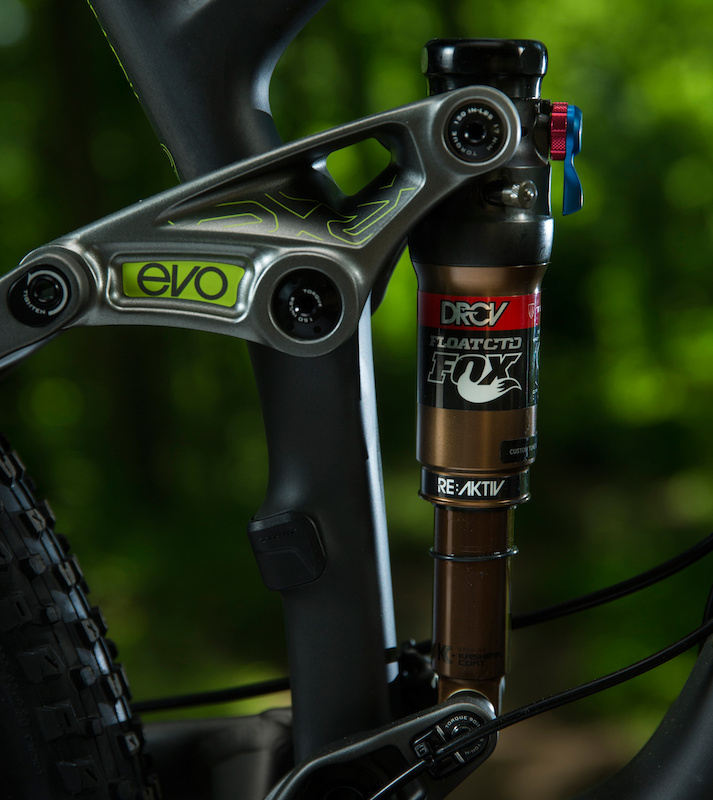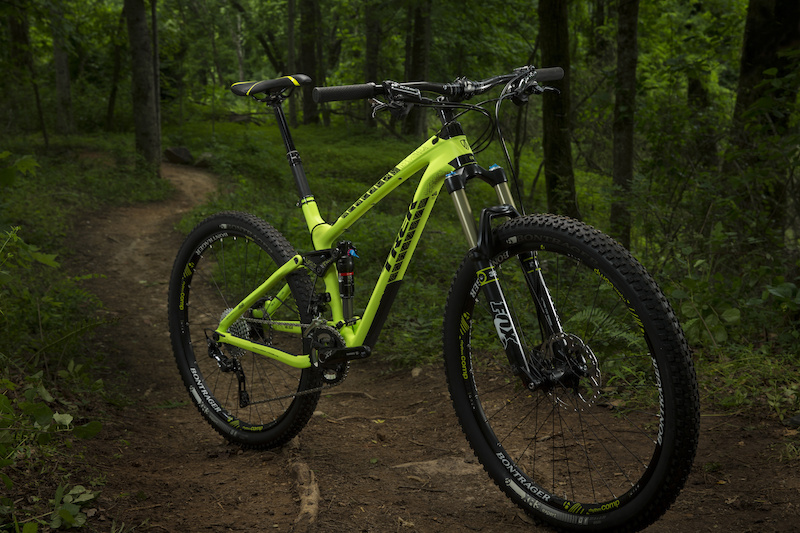RE:aktiv Suspension - F1 and MTB Collide
Source: Trek
Waterloo, WI – Five years after forming a research and development relationship with Penske Racing Shocks, Trek is unveiling the ground-breaking RE:aktiv suspension on an all-new Fuel EX 27.5. Trek’s pursuit of a breakthrough suspension innovation led them the industry leader in custom suspension solutions for top tier automotive race teams: Penske Racing Shocks.
RE:aktiv Suspension
RE:aktiv was born of a partnership between Trek, Penske, and FOX. Penske Racing Shocks supplies custom suspension solutions for the world’s top automotive race teams, including top Formula One programs. No mass-manufacturing for the consumer market; Only high-end custom solutions for the most demanding conditions and customers. After a serendipitous meeting between Penske Racing Shocks' Technical Director Jim Arentz and Trek’s Director of MTB Frame Technology Dylan Howes at a NASCAR race, the two companies began talking about the potential for Penske Racing Shock’s custom innovations in the world of mountain bikes.

Given the prestige and demand for Penske's suspension designs in auto racing, the mountain bike world should be very excited about their future involvement.
RE:aktiv is a patent-pending exclusive technology available only on Trek mountain bikes. RE:aktiv makes its' debut on an all-new Fuel EX 27.5 with select models available immediately exclusively through Trek's worldwide retailer network. The entire lineup is expected to be available later this summer.
Want to know more about Penske Racing Shocks' involvement in the suspension on Trek's new Remedy 29 Carbon and Fuel EX 27.5 models? Stay tuned for an in-depth piece on the technology where we explain exactly how it functions.
Waterloo, WI – Five years after forming a research and development relationship with Penske Racing Shocks, Trek is unveiling the ground-breaking RE:aktiv suspension on an all-new Fuel EX 27.5. Trek’s pursuit of a breakthrough suspension innovation led them the industry leader in custom suspension solutions for top tier automotive race teams: Penske Racing Shocks.
RE:aktiv was born of a partnership between Trek, Penske, and FOX. Penske Racing Shocks supplies custom suspension solutions for the world’s top automotive race teams, including top Formula One programs. No mass-manufacturing for the consumer market; Only high-end custom solutions for the most demanding conditions and customers. After a serendipitous meeting between Penske Racing Shocks' Technical Director Jim Arentz and Trek’s Director of MTB Frame Technology Dylan Howes at a NASCAR race, the two companies began talking about the potential for Penske Racing Shock’s custom innovations in the world of mountain bikes.

After thorough collaborative effort the teams landed on the remarkable potential of regressive damping to achieve what inertia valves have been unsuccessfully attempting in the mountain bike world for years. Regressive damping had been utilized in Formula One racing and then moved over to Indy Car and NASCAR with much success. It provides a much firmer hold in straights and corners for incredible support, but when it hits a sudden obstacle, like the square angles encountered on technical trails, the shock’s hold instantly gives way to a plush, controlled progression. In short, the shock was smart enough to get out of its own way… fast. The result of the mountain bike application of this concept is RE:aktiv, which delivers on the unrealized potential of an inertia valve. And to date, regressive damping had never been used in mountain biking.
FOX Racing Shocks was brought into the process at a pivotal moment of the development process. FOX applied their suspension expertise and manufacturing prowess to the new shock to help bring RE:aktiv to market. RE:aktiv is a joint partnership among Trek, Penske Racing Shocks, and FOX. "The thing about Penske is they're completely focused
on being a racing company. So what we're doing is leveraging their R&D resources and turning that into almost an extension of our own capabilities," said Trek Director of Suspension Development Jose Gonzalez. "The combined effort with Fox providing the production expertise has produced just an outstanding shock."FOX Racing Shocks was brought into the process at a pivotal moment of the development process. FOX applied their suspension expertise and manufacturing prowess to the new shock to help bring RE:aktiv to market. RE:aktiv is a joint partnership among Trek, Penske Racing Shocks, and FOX. "The thing about Penske is they're completely focused
 | The unique thing about Penske and Trek is that we've really only scratched the surface. Regressive technology helped with one compromise that was there in mountain biking but there's a whole other world of technologies that may apply. Not only from Formula One but all the markets we work with. - Bill Gartner, Penske Racing Shocks Director of Research and Development |
Given the prestige and demand for Penske's suspension designs in auto racing, the mountain bike world should be very excited about their future involvement.
RE:aktiv is a patent-pending exclusive technology available only on Trek mountain bikes. RE:aktiv makes its' debut on an all-new Fuel EX 27.5 with select models available immediately exclusively through Trek's worldwide retailer network. The entire lineup is expected to be available later this summer.
Author Info:
Must Read This Week
[UPDATED] Final Elite XC Results & Overall Standings from the Mairiporã XC World Cup 2024
41908 views
41908 views
Sign Up for the Pinkbike Newsletter - All the Biggest, Most Interesting Stories in your Inbox
PB Newsletter Signup



www.foesjapan.com/cnt.html
The foes history page goes quite a bit into their partnership with Curnutt, and the technology they crafted into their suspension.
foesracing.com/bikes/index.php/history
Regardless, its great to see technology being benchmarked from other purposes and trickling down to mass production in bikes!
Go ride the 10 year old fork your talking about then. Don't buy one.
I guess you know more than the research and development departments of Trek and Penske.
Dam u smart Deemax.
What you do for work ?
Sounds like you should start your own bike company and show em how it's done.
Or just shut your hole - that would be just as good.
@slidways you cannot achieve this curve with "a rebuild and oil weights" or even major reshimming of any valve geometry currently on the market. Call it what you want, but Trek's claim that this is actually different from anything currently in the bike world is objectively correct. Whether it's actually better than Terralogic/Brain technology in the real world though is anyone's guess at this point, but it wouldn't be hard to improve on the Brain, to put it nicely.
Question for Mr Camp and also Penske - given Penske's push over the years to minimise hysteresis through pressure balancing, how did you get around the issues you'd expect from the massive hysteresis inevitably found in regressive mechanical valves?
I'd love to know exactly how it differs from a more normal shock, but I guess I'll have to wait. And I wait with baited breath. I ride a Session myself, and it is absolutely f*cking awesome. I couldn't be happier, but I do find myself maxing out the LSC at both ends on smoother flow/jump (boring) tracks to get the maximum pop off of lips etc and make it more fun, but then have to wind it all back off again when I ride a proper manly track. This system sounds like it might offer exactly the performance I am looking for without all the fiddling. Can't wait to see more
Please wait and ride one before passing judgement.
@Vorsprung Suspension- We never really chased down the hysteresis... It has some, but less than you might think- as the valve slows down at the end of a bump event, the valve still flows oil pretty easily since it has already cracked open. The huge pressure buildups/differential are only on opening the valve.
An interesting thing to think about is that even though those graphs you posted have terrible hysteresis in rebound, the cars are still going faster using them. I think Bill says it in one of the videos, but Penske would rather just bolt a shock on a car and see what the lap times do rather than analyse graphs for months. I tend to agree with him on that front
"Look, the computer says we can remove over 2 lbs of material without any negative side effects!! Oh shit, best warn the warranty dept...."
www.shimrestackor.com/Code/Sample_Applications/Damping_Profile/damping-profile.htm
You can, maybe it wont be as effective as this as it uses certain ports but you can get a shock to follow this same curve.
@dave - I agree, if there is a net benefit then it's still an improvement overall even if some aspects are theoretically (or even practically) worse. I'm interested to try one of these things.
www.pinkbike.com/news/Push-Industries-Air-Volume-Tuning-Kit-for-FoxTrek-DRCV-Forks-and.html
What makes this situation any different? re: - the prehype marketing campaign and then the potential for a major let down on once this hits the trail.
Why should you be trusted?
Also will the bb again be very high? Why won't we get a trailbike that feels in corners at least like a dh bike from 5 years ago. Spesh did it with the Pitch quite some time ago
The valve uses different pressure area's when open and closed to create this buildup of pressure and then blowoff effect. When the valve is closed, oil pressure is pushing through a few small holes which are blocked by a plate held down by a spring. When oil pressure over-comes the spring pressure, the plate moves back and oil can start to flow through the holes and through the plate (which also has holes in it). When this happens, oil pressure is now exposed to the full face area of the plate- instead of the small holes- so the plate is blown back, creating a much easier/larger flow area for oil, and you get the decrease in force.
TL/DR: The valve uses clever geometry and layout to give lots of LSC damping, then blowoff on highspeed hits.
@terrafire- he got it about the licensing
The article talks about this not being a speed sensitive valve, but your description implies it's very similar to a LSC, but with a blow off. What prevents this (fairly high level) of LSC from causing high speed chatter to transmit straight to the rider? it seems that it would be hard to get the "stand up" effect without reducing shock travel during small hits. Corollary question: does this valve affect the entire stroke of the shock, or does it engage at a certain point in the travel, like a mid valve?
In terms of system response and ride feel, how would you say this differs from Spec Brain (for example)? I would think maybe faster/less noticeable blowoff threshold, since it doesn't have to move a mass before flow can start? Also very cool that it accomplishes the similar concept without need for a remote unit all the way at the back wheel. Any thoughts on how this will compare performance- and feel-wise?
Is there a patent (or patents) I could look up to learn more?
I had a spec epic for a while and actually liked the brain a lot, but I was also a worse rider then so I don't necessarily remember the nuances of shock feel and all that. Loved being able to seamlessly transition from rocks to pedaling short smooth sections without hitting switches.
The brain shock feels like it is switching the lockout lever off and on. This shock just feels efficient and settled but without the off/on switching feel of a brain shock.
shop.penskeshocks.com/files/downloads/ETM%2012.1%20REG-A.pdf
You are very correct about the cost issues. We had to fit into our standard DRCV package and retain all standard adjusters. anything else and the project would have been killed due to the shocks costing way too much.
Are you able to discuss any testing or plans to add this damping to the forks?
It seems like a decent idea to have it matched on both ends.
I am very interested to ride this once I saw that it will be available on the Remedy too.
this is EXACTLY how the MoCo IS works..... which is like 7-8 years old.
(It should also be noted that in terms of control precision, Motion Control ranks as the all time lowest of any damper I've ever seen, but that doesn't mean it's not better than a simple ported damper - more precision does not necessarily mean superior performance, but it can help).
I've used Penske shocks on my motorcycles, they are expensive but they work well with minimal fuss as far as tuning. I wonder how they will do with Fox and Trek knowledge added on top of their damping knowledge. Bring on the demo dates!
@okayh that is a different piston and valve assembly. We used the 'Regressive' valve from Penske.
Late entry into the conversation but do you feel this regressive damper has a larger tune window for us fatty riders?
www.formula1news.net/the-2014-f1-turbo-cars-pictures-and-specifications
Look at the Mercedes W05
Dampers: Penske
see also Force India, Torro Rosso and Caterham
meh.
^^^^This
But this is all speculation, and I'd be interested to try.
Re:Aktiv is the damper.
But yes- you can maybe go down a little in springrate and still have efficient pedaling. It is not an inertia valve like Specialized' brain shocks.
@wakaba it is not like that at all. You should ride one before passing judgement
Im sorry if you can get things wet
But please enlighten me on how a regressive spring curve not work with an "inertia valve" ( in all is possible aspects ) ?? I guess suspension dynamics must evade me, and I never said it was bad.... Just marketing going nuts again over something not so new...
I still see a switch on the shock, so that means I have to do something to operate the different modes like climb, trail, decent. What makes this better than my current Fox shock?
Specialized Brain shock is already doing an amazing job at this. I rode an Epic for a whole season and personally could not get used to feeling like I had a hard tail and slowing down much more than I had to for bumps, only to realize that Specialized Brain worked so well, I could have carried my speed. I don't see any advantage to this shock. There was no lever to change settings on the Brain and it would go from locked to full open smoothly and quickly.
The video is more like a eharmony 3-way success story than anything interesting from a mountain biker's perspective...
Stoked to see what's actually different with this "regressive" damping technology.
Why not buy something like a pivot that uses frame and linkage technology to achieve the same thing that Trek and Specialized have to do through proprietary shocks?
The main difference the best that I understand and can summarize:
Spec Brain uses the inertia of a brass weight balanced with a spring, activated from wheel impact (all mounted in a remote location) to open/close shock valving.
vs
Trek RE:aktiv uses a special spring and washer configuration (in the main shock body) activated based on shock speed to control valving. Firm for slow shock motion (i.e. pedaling forces), open for fast shock motion (i.e. real bump absorption.)
The Trek system should be less troublesome than the remote Brain, and may actually react with less delay than what occurs when the Brain is set firm. It takes a good hit to open up if set firm which makes a solo bump or the first hit in a series bigger than without the Brain.
I love the concept. I'm going to test ride to see if reality matches the claims.
@Phobospwns: Please tell me your name is a Quake 3 Arena reference. If Carlsberg made video games.....